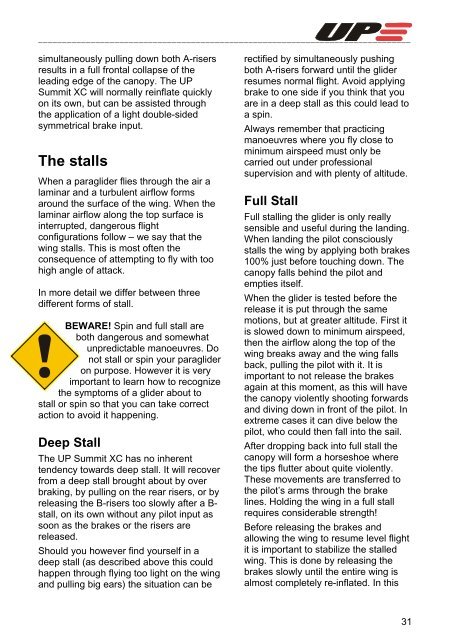Owners Manual and Service booklet
Owners Manual and Service booklet
Owners Manual and Service booklet
Create successful ePaper yourself
Turn your PDF publications into a flip-book with our unique Google optimized e-Paper software.
______________________________________________________________________________<br />
simultaneously pulling down both A-risers<br />
results in a full frontal collapse of the<br />
leading edge of the canopy. The UP<br />
Summit XC will normally reinflate quickly<br />
on its own, but can be assisted through<br />
the application of a light double-sided<br />
symmetrical brake input.<br />
The stalls<br />
When a paraglider flies through the air a<br />
laminar <strong>and</strong> a turbulent airflow forms<br />
around the surface of the wing. When the<br />
laminar airflow along the top surface is<br />
interrupted, dangerous flight<br />
configurations follow – we say that the<br />
wing stalls. This is most often the<br />
consequence of attempting to fly with too<br />
high angle of attack.<br />
In more detail we differ between three<br />
different forms of stall.<br />
BEWARE! Spin <strong>and</strong> full stall are<br />
both dangerous <strong>and</strong> somewhat<br />
unpredictable manoeuvres. Do<br />
not stall or spin your paraglider<br />
on purpose. However it is very<br />
important to learn how to recognize<br />
the symptoms of a glider about to<br />
stall or spin so that you can take correct<br />
action to avoid it happening.<br />
Deep Stall<br />
The UP Summit XC has no inherent<br />
tendency towards deep stall. It will recover<br />
from a deep stall brought about by over<br />
braking, by pulling on the rear risers, or by<br />
releasing the B-risers too slowly after a B-<br />
stall, on its own without any pilot input as<br />
soon as the brakes or the risers are<br />
released.<br />
Should you however find yourself in a<br />
deep stall (as described above this could<br />
happen through flying too light on the wing<br />
<strong>and</strong> pulling big ears) the situation can be<br />
rectified by simultaneously pushing<br />
both A-risers forward until the glider<br />
resumes normal flight. Avoid applying<br />
brake to one side if you think that you<br />
are in a deep stall as this could lead to<br />
a spin.<br />
Always remember that practicing<br />
manoeuvres where you fly close to<br />
minimum airspeed must only be<br />
carried out under professional<br />
supervision <strong>and</strong> with plenty of altitude.<br />
Full Stall<br />
Full stalling the glider is only really<br />
sensible <strong>and</strong> useful during the l<strong>and</strong>ing.<br />
When l<strong>and</strong>ing the pilot consciously<br />
stalls the wing by applying both brakes<br />
100% just before touching down. The<br />
canopy falls behind the pilot <strong>and</strong><br />
empties itself.<br />
When the glider is tested before the<br />
release it is put through the same<br />
motions, but at greater altitude. First it<br />
is slowed down to minimum airspeed,<br />
then the airflow along the top of the<br />
wing breaks away <strong>and</strong> the wing falls<br />
back, pulling the pilot with it. It is<br />
important to not release the brakes<br />
again at this moment, as this will have<br />
the canopy violently shooting forwards<br />
<strong>and</strong> diving down in front of the pilot. In<br />
extreme cases it can dive below the<br />
pilot, who could then fall into the sail.<br />
After dropping back into full stall the<br />
canopy will form a horseshoe where<br />
the tips flutter about quite violently.<br />
These movements are transferred to<br />
the pilot’s arms through the brake<br />
lines. Holding the wing in a full stall<br />
requires considerable strength!<br />
Before releasing the brakes <strong>and</strong><br />
allowing the wing to resume level flight<br />
it is important to stabilize the stalled<br />
wing. This is done by releasing the<br />
brakes slowly until the entire wing is<br />
almost completely re-inflated. In this<br />
31


